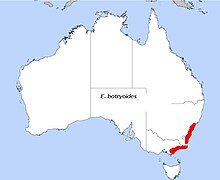Eucalyptus botryoides
| Bangalay, Southern Mahogany | |
|---|---|
 |
|
| Eucalyptus botryoides, Melbourne | |
| Scientific classification | |
| Kingdom: | Plantae |
| Clade: | Angiosperms |
| Clade: | Eudicots |
| Clade: | Rosids |
| Order: | Myrtales |
| Family: | Myrtaceae |
| Genus: | Eucalyptus |
| Species: | E. botryoides |
| Binomial name | |
|
Eucalyptus botryoides Sm. |
|
 |
|
| E. botryoides, field distribution | |
Eucalyptus botryoides, commonly known as the Bangalay, bastard jarrah, woollybutt or Southern Mahogany, is a small to tall tree native to southeastern Australia. Reaching up to 40 metres (130 feet) high, it has rough bark on its trunk and branches. It is found on sandstone- or shale-based soils in open woodland, or on more sandy soils behind sand dunes. The white flowers appear in summer and autumn. It reproduces by resprouting from its woody lignotuber or epicormic buds after bushfire. E. botryoides hybridises with the Sydney blue gum (E. saligna) in the Sydney region. The hard, durable wood has been used for panelling and flooring.
The tree was first described by naturalist James Edward Smith in 1797, without nominating a type specimen, and still bears its original name. The species name is derived from the Ancient Greek botrys "cluster", and may relate to the clustered flowerheads and fruit. It has been classified in the subgenus Symphyomyrtus, Section Latoangulatae, Series Annulares (red mahoganies) by Brooker and Kleinig. Its closest relatives are the red mahogany (Eucalyptus scias) and the Blue Mountains mahogany (E. notabilis), red mahogany/red messmate (E. resinifera) and swamp mahogany (E. robusta). South of Sydney Harbour and Parramatta River, E. botryoides forms hybrid populations with Sydney blue gum (E. saligna).
In favourable conditions, Eucalyptus botryoides can grow as a straight-trunked tree to 40 m (130 ft) high with a dbh of 1 m (3.3 ft), although it is often shorter in poorer situations. In exposed areas behind sand dunes, it is a lower spreading tree 6–12 m (20–39 ft) tall, with its leaves forming a dense crown, or even a multitrunked mallee form in poor sandy soils. It has a swollen woody base known as a lignotuber which can reach 6 m (20 ft) in diameter. The thick, fibrous, rough and flaky bark covers the trunk and larger branches, and is vertically furrowed. The bark is more greyish brown in trees of inland forest origin, and a redder brown in those of more coastal origin. The bark on smaller branches is smooth and pale grey.
...
Wikipedia
